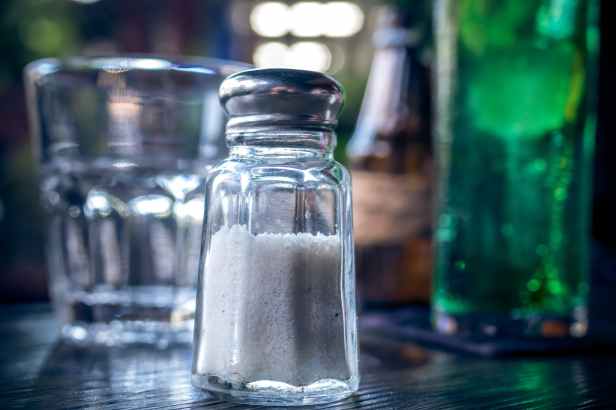When diagnosed with hypotension, or low blood pressure, a common “fix” many doctors recommend is to increase your sodium, or salt, intake. It seems like eating a large amount of salt would be unhealthy, but salt by itself has many important roles in the body.

Why is Salt Important?
Your body’s cells require certain ions, which includes NaCl (salt) and K (potassium) to work properly– without the correct ratio of the two, you can actually harm your body, especially your heart.
As an example, I have increased SVT (heart arrhythmia) occurrences when I am very dehydrated and have low potassium levels. This phenomenon makes sense, since SVTs are an electrical problem with the heart and having low potassium and being dehydrated can make the heart’s electrical system go wonky.
In most instances, having severe symptoms only happens after extreme dehydration and luckily for most people, that is a rare occurrence. However, people with chronic illness often face chronic dehydration and must be careful to maintain proper electrolyte balance and hydration.
Salt is typically seen as bad because many people associate high salt with high blood pressure. If you are reading this, you likely are having troubles with the opposite– with low blood pressure.
When you are dehydrated, have low blood volume or low blood pressure, there is not enough fluid in your body to keep everything moving and you begin to have symptoms such as high heart rate, dizziness, headaches, and fainting.
For this reason, we are often advised to increase our salt intake with an increase in fluids to improve fluid retention in the body, which raises blood pressure. Whenever your cells are filled with salt, they also take in more water to even out the salt within the cells. So drinking water plain won’t always help blood pressure, because you will probably just pee it out.
So what are some ways to increase your salt intake? Luckily, I’ve created a list of top sodium-containing foods to help you get your daily salt-fix.
I have a MASSIVE problem with physicians recommending fast food as an option to increase sodium. I don’t think salt is America’s problem. I think what the salt is in is the problem. There is no way that eating fast food is “healthy,” so I will never recommend that on this site.
There are many more healthy alternatives to increasing salt without buying a lot of heavily processed food.
Here are my top 5:

1. Soy Sauce
Soy sauce also has an intense amount of sodium per serving. On average, a tamari soy sauce (naturally gluten-free) contains 1,000 mg sodium per tablespoon (18 grams). Coconut aminos are a soy-free alternative to soy sauce. Trader Joe’s coconut aminos have 300mg per tablespoon. I don’t eat soy products, so I stick with the coconut aminos, but if you are pro-soy, this is your best bet.
2. 365 Organic Chicken Broth
Whole Foods has a really tasty chicken broth that contains a LOT of sodium. Each cup (240mL) contains 600 mg of sodium. On bad days, I like heating up a mug of chicken broth in the morning to boost my sodium fast.
3. Pickles
Pickles is a POTS go-to. Personally, I do not eat pickles because of GERD (acid reflux); however, it would be ridiculous to not share the high-sodium glory pickles offer. On average, one large pickle contains 1600 mg of sodium.
4. Sweet Potato Chips
I love sweet potatoes, which means I definitely love sweet potato chips. What tastes really good with sweet potato chips? Salt. This may sound crazy, but dipping sweet potato chips in Himalayan sea salt is delicious. Try it and let me know what you think!
5. Celtic Sea Salt
I also believe that the type of salt you eat matters. Celtic sea salt is an unrefined salt that still contains essential minerals. If you buy the coarse version, you can easily increase your salt through this sea salt alone without your food actually tasting that salty. You can also make a homemade version of everything above except the soy sauce and use this salt in the recipes. ¼ tsp (1.5g) there is 480 mg of sodium. What a win!
Side note: If you need more iodine in your diet, you can try eating kelp chips! Sounds nasty, but they are actually super tasty.

How I get my daily salt:
3 packets of TRIORAL= 2.6 grams x 3= 7.8 grams of salt
Approximately 1 tsp of Celtic sea salt= 480 mg x 4 = 1.9 grams of salt
Total: about 10 grams of salt.
Hopefully this guide helps you supplement your salt intake to your physician’s recommended suggestions! Comment below with other ideas.

Wow this was super interesting and helpful. Awesome post!
LikeLike
Thank you! I am glad it was helpful for you!
LikeLike
What do you think of the taste of Trioral? I’ve been supplementing with it for a few months, but find it a bit too salty. Have you just gotten used to it, or do you add lemon or some other flavoring to counteract the saltiness?
Great recommendations!! 🙂
LikeLike
I think it tastes sweet versus salty and just drink it plain. I definitely got used to the taste overall over time. I usually drink 2-4 a day.
LikeLiked by 1 person
That’s good to hear you’ve gotten used to the taste–hopefully I will, as well. 🙂 How funny that our taste buds perceive it differently!
LikeLike